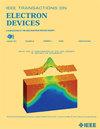Enhanced Charge Transport in Organic Thin-Film Transistors Through Environmentally Benign MXene-P3HT Nanocomposites
IF 3.2
2区 工程技术
Q2 ENGINEERING, ELECTRICAL & ELECTRONIC
引用次数: 0
Abstract
In this work, we report the synthesis of MXene (Ti2CTX) nanobelts from its MAX (Ti2AlC) phase via hydrothermal treatment with 5 M NaOH. This is an environmentally friendly and safer alternative to traditional HF-based etching processes. This approach reduces risks to health and handling concerning HF but maintains the exfoliation quality of the MXene layers. The Ti2CTX nanobelts were then incorporated at various concentrations into poly(3-hexylthiophene) (P3HT) matrices to form nanocomposite films using the unidirectional floating film transfer method (UFTM). These aligned hybrid films showed dramatically improved charge transport properties compared to pristine P3HT. For instance, adding 3% (v/v) MXene increased the charge carrier mobility from 0.05 cm2V利用环境友好型MXene-P3HT纳米复合材料增强有机薄膜晶体管中的电荷输运
本文报道了以MAX (Ti2AlC)相为原料,用5 M NaOH水热法制备MXene (Ti2CTX)纳米带。这是一种环保和安全的替代传统的基于hf的蚀刻工艺。这种方法降低了对健康和处理HF的风险,但保持了MXene层的去角质质量。然后将不同浓度的Ti2CTX纳米带掺入聚(3-己基噻吩)(P3HT)基质中,采用单向浮膜转移法(UFTM)形成纳米复合薄膜。与原始P3HT相比,这些排列的杂化膜显示出显著改善的电荷输运特性。例如,加入3% (v/v)的MXene可将载流子迁移率从0.05 cm2V ${}^{-{1}}$ s ${}^{-{1}}$(原始P3HT)提高到0.57 cm2V ${}^{-{1}}$ s ${}^{-{1}}$,且通断电流比高达$10^{{5}}$。我们将这种改进归因于MXene纳米带的模板效应,它促进了P3HT链的取向排列,从而促进了有效的电荷传输途径。
本文章由计算机程序翻译,如有差异,请以英文原文为准。
求助全文
约1分钟内获得全文
求助全文
来源期刊

IEEE Transactions on Electron Devices
工程技术-工程:电子与电气
CiteScore
5.80
自引率
16.10%
发文量
937
审稿时长
3.8 months
期刊介绍:
IEEE Transactions on Electron Devices publishes original and significant contributions relating to the theory, modeling, design, performance and reliability of electron and ion integrated circuit devices and interconnects, involving insulators, metals, organic materials, micro-plasmas, semiconductors, quantum-effect structures, vacuum devices, and emerging materials with applications in bioelectronics, biomedical electronics, computation, communications, displays, microelectromechanics, imaging, micro-actuators, nanoelectronics, optoelectronics, photovoltaics, power ICs and micro-sensors. Tutorial and review papers on these subjects are also published and occasional special issues appear to present a collection of papers which treat particular areas in more depth and breadth.
 求助内容:
求助内容: 应助结果提醒方式:
应助结果提醒方式:


